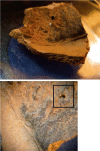Preserved Proteins from Extinct Bison latifrons Identified by Tandem Mass Spectrometry; Hydroxylysine Glycosides are a Common Feature of Ancient Collagen
- PMID: 25948757
- PMCID: PMC4587324
- DOI: 10.1074/mcp.M114.047787
Preserved Proteins from Extinct Bison latifrons Identified by Tandem Mass Spectrometry; Hydroxylysine Glycosides are a Common Feature of Ancient Collagen
Abstract
Bone samples from several vertebrates were collected from the Ziegler Reservoir fossil site, in Snowmass Village, Colorado, and processed for proteomics analysis. The specimens come from Pleistocene megafauna Bison latifrons, dating back ∼ 120,000 years. Proteomics analysis using a simplified sample preparation procedure and tandem mass spectrometry (MS/MS) was applied to obtain protein identifications. Several bioinformatics resources were used to obtain peptide identifications based on sequence homology to extant species with annotated genomes. With the exception of soil sample controls, all samples resulted in confident peptide identifications that mapped to type I collagen. In addition, we analyzed a specimen from the extinct B. latifrons that yielded peptide identifications mapping to over 33 bovine proteins. Our analysis resulted in extensive fibrillar collagen sequence coverage, including the identification of posttranslational modifications. Hydroxylysine glucosylgalactosylation, a modification thought to be involved in collagen fiber formation and bone mineralization, was identified for the first time in an ancient protein dataset. Meta-analysis of data from other studies indicates that this modification may be common in well-preserved prehistoric samples. Additional peptide sequences from extracellular matrix (ECM) and non-ECM proteins have also been identified for the first time in ancient tissue samples. These data provide a framework for analyzing ancient protein signatures in well-preserved fossil specimens, while also contributing novel insights into the molecular basis of organic matter preservation. As such, this analysis has unearthed common posttranslational modifications of collagen that may assist in its preservation over time. The data are available via ProteomeXchange with identifier PXD001827.
© 2015 by The American Society for Biochemistry and Molecular Biology, Inc.
Figures





Similar articles
-
Identification of Glycopeptides with Multiple Hydroxylysine O-Glycosylation Sites by Tandem Mass Spectrometry.J Proteome Res. 2015 Dec 4;14(12):5099-108. doi: 10.1021/acs.jproteome.5b00299. Epub 2015 Nov 13. J Proteome Res. 2015. PMID: 26565680
-
Development of a novel method for analyzing collagen O-glycosylations by hydrazide chemistry.Mol Cell Proteomics. 2012 Jun;11(6):M111.010397. doi: 10.1074/mcp.M111.010397. Epub 2012 Jan 13. Mol Cell Proteomics. 2012. PMID: 22247541 Free PMC article.
-
Comprehensive Characterization of Glycosylation and Hydroxylation of Basement Membrane Collagen IV by High-Resolution Mass Spectrometry.J Proteome Res. 2016 Jan 4;15(1):245-58. doi: 10.1021/acs.jproteome.5b00767. Epub 2015 Dec 9. J Proteome Res. 2016. PMID: 26593852 Free PMC article.
-
Collagen hydroxylysine glycosylation: non-conventional substrates for atypical glycosyltransferase enzymes.Biochem Soc Trans. 2021 Apr 30;49(2):855-866. doi: 10.1042/BST20200767. Biochem Soc Trans. 2021. PMID: 33704379 Review.
-
Identification of Regulatory Molecular "Hot Spots" for LH/PLOD Collagen Glycosyltransferase Activity.Int J Mol Sci. 2023 Jul 7;24(13):11213. doi: 10.3390/ijms241311213. Int J Mol Sci. 2023. PMID: 37446392 Free PMC article. Review.
Cited by
-
Modulation of receptor binding to collagen by glycosylated 5-hydroxylysine: Chemical biology approaches made feasible by Carpino's Fmoc group.Pept Sci (Hoboken). 2020 Jul;112(4):e24156. doi: 10.1002/pep2.24156. Epub 2020 Mar 19. Pept Sci (Hoboken). 2020. PMID: 33073165 Free PMC article.
-
Meta-proteomic analysis of two mammoth's trunks by EVA technology and high-resolution mass spectrometry for an indirect picture of their habitat and the characterization of the collagen type I, alpha-1 and alpha-2 sequence.Amino Acids. 2022 Jun;54(6):935-954. doi: 10.1007/s00726-022-03160-6. Epub 2022 Apr 17. Amino Acids. 2022. PMID: 35434776 Free PMC article.
-
Preservation of collagen in the soft tissues of frozen mammoths.PLoS One. 2021 Oct 29;16(10):e0258699. doi: 10.1371/journal.pone.0258699. eCollection 2021. PLoS One. 2021. PMID: 34714842 Free PMC article.
-
Taphonomic and Diagenetic Pathways to Protein Preservation, Part II: The Case of Brachylophosaurus canadensis Specimen MOR 2598.Biology (Basel). 2022 Aug 5;11(8):1177. doi: 10.3390/biology11081177. Biology (Basel). 2022. PMID: 36009804 Free PMC article.
-
Proteomic profiling of archaeological human bone.R Soc Open Sci. 2017 Jun 7;4(6):161004. doi: 10.1098/rsos.161004. eCollection 2017 Jun. R Soc Open Sci. 2017. PMID: 28680659 Free PMC article.
References
-
- Smejkal G. B., Schweitzer M. H. (2007) Will current technologies enable dinosaur proteomics? Expert Rev. Proteomics 4, 695–699 - PubMed
-
- Ostrom P. H., Schall M., Gandhi H., Shen T.-L., Hauschka P. V., Strahler J. R., Gage D. A. (2000) New strategies for characterizing ancient proteins using matrix-assisted laser desorption ionization mass spectrometry. Geochim. Cosmochim. Acta 64, 1043–1050
-
- Hofreiter M., Collins M., Stewart J. R. (2012) Ancient biomolecules in Quaternary palaeoecology. Quat. Sci. Rev. 33, 1–13
Publication types
MeSH terms
Substances
Grants and funding
LinkOut - more resources
Full Text Sources
Research Materials

